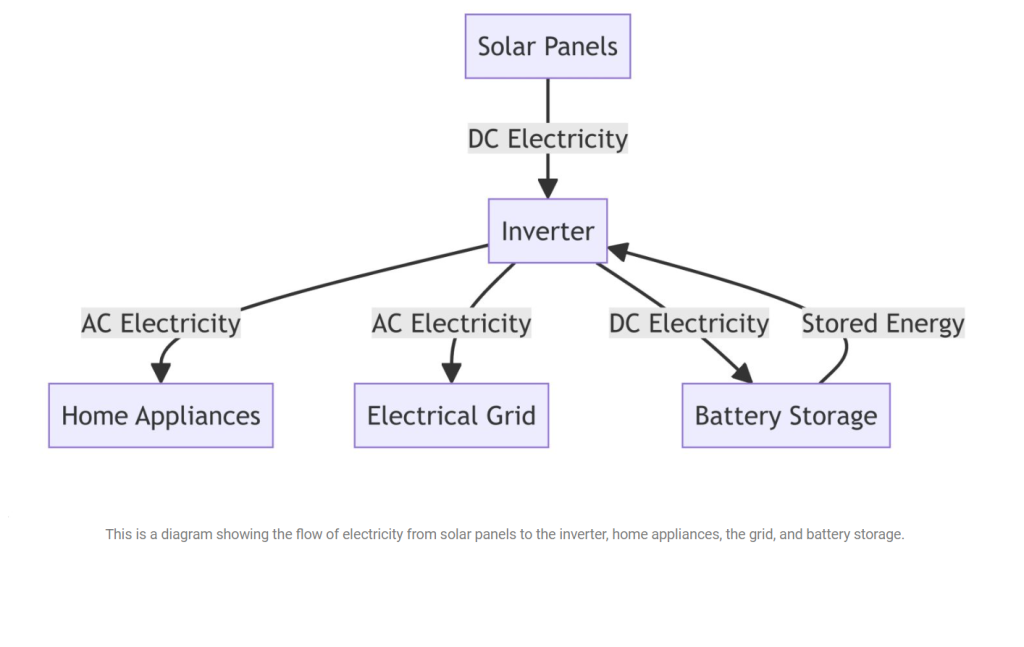Solar Products!
UNDERSTANDING SOLAR INVERTERS
WHAT IS A SOLAR INVERTER?
A solar inverter is another name given for the so-called brains of any solar energy system. They are important parts that convert Direct Current (DC) electricity harnessed through solar panels to Alternating Current (AC) electricity. This is important since most household appliances and the electrical grid are based on AC power. Without a solar inverter, energy collected from solar panels would not be immediately helpful in standard residential and commercial applications.
DIAGRAM OF INTEGRATED SOLAR PANEL INSTALLATION

TYPES OF SOLAR INVERTERS
Solar inverters come in various types, each with relative merits and suitable applications
- String Inverters
String Inverters are the most common type of inverters used in residential solar installations. They connect a series of solar panels (a string) to a single inverter. While more cost-effective, their performance can be largely adversely affected by shading or panel mismatching.
- Microinverters
Microinverters differ from string inverters in their installation on every solar panel. They make the performance of individual panels optimal, such as in installations where shading is an issue. Microinverters also have some monitoring enhancements.
- Power Optimisers
These devices operate with a string inverter. Each solar panel is attached with power optimizers that optimize output before transmitting DC electricity to the central inverter. This provides an optimal trade-off between cost efficiency as entailed by string inverters and performance optimization provided by microinverters.
- Hybrid Inverters
Also known as a multi-mode inverter, this device performs dual functionalities as a solar inverter and a battery inverter. They are particularly well suited for use within a system that has energy storage solutions to enhance energy independence and ensure the resilience of the system.
THE MAIN COMPONENTS OF THE SOLAR INVERTER ARE DISCUSSED NEXT, DESCRIBING ITS GENERAL OPERATION
- DC-AC Converter
This is the core component that performs the conversion from DC to AC.
- MPPT (Maximum Power Point Tracking)
This is the technology that optimizes the working of solar panels by adjusting the electric operating points.
- Microcontroller
It controls the operations and makes them efficient.
- Cooling System
Maintains optimal operating temperatures to prevent overheating and improve longevity.
BENEFITS OF SOLAR INVERTERS
- Commanding Energy Efficiency and Cost Savings
Solar inverters boost the overall efficiency of solar power systems, ensuring that the maximum generated solar energy is converted and utilized. This translates to substantial cost savings, evidenced by low electricity bills, hence an investment that would be very wise for both residential and commercial property owners.
- Environmental Impact
The use of solar inverters leads to a reduction in carbon emissions through the promotion of the use of renewable sources of energy. Advancing clean energy contributes to the fight against climate change and reduces the reliance on fossil fuels.
- Enhance Grid Stability
Modern-day solar inverters have several advanced grid support functions. They can modulate voltage, frequency, and reactive power, which in turn helps with maintaining the stability and dependability of the grid.
- Solar Independence
Solar inverters, particularly those combined with battery storage, introduce energy independence since consumers can produce, store, and manage their electricity. This is a capability liked most in regions with unreliable power sources.
INSTALLATION AND MAINTENANCE
- Installation Process
The process of installing solar inverters incorporates the following procedures to ensure high performance, coupled with safety
- Site Assessment
A study of a site that reveals its best use for positioning solar panels and inverters.
- System Design
A PV-based solar system will be designed after determining the energy needs and its physical location.
- Mounting Panels
Attachment of the solar panels to roof, ground, or pole mounts.
- Electrical Hookup
Wiring the panels to the inverter, eventually into the electrical grid or battery storage.
- Installation of Inverter
Installing and, in some situations, setup of an inverter capable of a satisfactory performance.
- System Testing
Testing of the general system for performance and safety.
MAINTENANCE TIPS
- Clean the Inverter
Dust and debris may impact the performance. Clean the inverter, and do not block the ventilation.
- Check Connections
Regularly check all the electrical connections for wear and tear, which can be a problematic cause.
- Monitor Performance
Use systems of monitoring to follow how it works and to detect any problems with the inverter on time.
- Keep Firmware Updated
Keep the firmware of the inverter updated with the latest features and enhancements.
FUTURE TRENDS IN SOLAR INVERTER TECHNOLOGY
- Increased Efficiency and Advanced Features
The next steps in the solar inverter industry point toward increased efficiency and the infusion of advanced features. Research and development involving artificial intelligence and machine learning will improve predictive maintenance and system optimization.
- Inclusion in Smart Grids
As intelligent grid technology progresses, solar inverters will be a crucial player for bidirectional energy flow and grid interaction. This can facilitate advanced management and distribution of energy.
- Enhanced Cybersecurity
As the digital nature of inverters increases, one of the critical concerns addressed will be cybersecurity. Advanced in-built security features will grace the inverters of tomorrow.
In conclusion, solar inverters are an indispensable component of solar energy systems, offering numerous benefits from enhanced energy efficiency to environmental sustainability. By understanding their functionalities, types, and maintenance requirements, one can maximise the advantages of solar power and contribute to a greener future.

